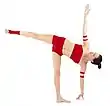Salabhasana
Salabhasana, Shalabhasana (Sanskrit: शलभासन; IAST: Śalabhāsana), Locust pose,[2] or Grasshopper pose[3] is a prone back-bending asana in modern yoga as exercise.[4]

Etymology and origins

The name comes from the Sanskrit शलभा "shalabh" which means "grasshopper" or "locust".[5]
The pose is not found in the medieval hatha yoga texts. It is described independently in Swami Vishnudevananda's 1960 Complete Illustrated Book of Yoga in the Sivananda Yoga tradition, and by B. K. S. Iyengar in his 1966 Light on Yoga, implying that it may have older origins.[6] A similar pose was found in Western gymnastics such as in The Bagot Stack Stretch-and-Swing System, 1931, though Bagot had visited India.[1]
Description
Salabhasana is entered from a prone position. The legs are stretched out straight and lifted; the arms are stretched straight back, palms down, and lifted; the head is lifted and the gaze is directed straight ahead.[5] It is a back bend, or spine stretch, utilizing the strength of the upper and middle back to lift the weight of the legs as high as possible from a starting position while face down on the floor. It improves flexibility and coordination, exercises the back muscles, and increases strength and stamina.[7]
Variations
Variations include:
In Bikram Yoga, Salabhasana has three stages.[11] The asana of the same name in Ashtanga Vinyasa Yoga corresponds to stage three of the Bikram style asana.
Preparatory asanas
In several styles of yoga, including Bikram Yoga and Astanga Yoga, Salabhasana is commonly performed after Bhujangasana, a related asana working on a different part of the spine.
See also
- Bhujangasana, Cobra Pose, another reclining backbending asana
References
- Stack, Mary Bagot (1931). Building the Body Beautiful, the Bagot Stack Stretch-and-Swing System. Chapman and Hall.
- "Locust Pose". Yoga Journal. Retrieved 11 April 2011.
- Yesudian, Selvarajan; Haich, Elisabeth (January 1953). Yoga and health. Harper. p. 139.
- Salabhasana http://yoganga.com/articles/salabhasana/
- Mehta 1990, p. 92.
- Sjoman, Norman E. (1999) [1996]. The Yoga Tradition of the Mysore Palace (2nd ed.). Abhinav Publications. p. 88. ISBN 81-7017-389-2.
- Stiles, Mukunda (2000). Structural Yoga Therapy: Adapting to the Individual. Red Wheel. ISBN 1-57863-177-7.
- Pratap, Vijayendra (15 September 1997). Beginning Yoga. Tuttle Publishing. p. 26. ISBN 978-0-8048-2104-9.
- Mohanty. Managing Common Musculoskeletal Conditions by Physiotherapy & Yoga. Jaypee Brothers Publishers. p. 15. ISBN 978-81-8448-357-4.
- Locust Pose. Yoga Journal. August 1996. p. 14.
- "Salabhasana | Locust". BYC. Retrieved 2 January 2019. (Three web pages)
Further reading
- Iyengar, B. K. S. (1 October 2005). Illustrated Light On Yoga. HarperCollins. ISBN 978-81-7223-606-9.
- Mehta, Silva; Mehta, Mira; Mehta, Shyam (1990). Yoga: The Iyengar Way. Dorling Kindersley.
- Saraswati, Swami Satyananda (1 August 2003). Asana Pranayama Mudra Bandha. Nesma Books India. ISBN 978-81-86336-14-4.
_from_Jogapradipika_1830_(detail).jpg.webp)
